Lemon - a tree of the genus Citrus, everyone knows its fruit. The homeland of this plant is China, India and the Pacific Islands.
Lemon was first introduced by the Arabs to the Middle East, North Africa, Spain and Italy.
Table of contents
Is it possible to grow a lemon from a stone at home?
About the benefits of lemon people know firsthand. Lemon is an excellent remedy for many ailments.. It strengthens the immune system, normalizes hormones, improves eyesight, stimulates the digestive tract.
It is used for colds, as there is a huge amount of vitamin C in it and many just like the sour, aromatic taste.
The man who decided to plant a lemon at home It is important to consider the following rules.:
- the fruit must be yellow, the most ripe, since if the lemon is green, then due to the fact that it has not ripened, the embryos of the seeds in the pits of such a lemon may not sprout;
- for planting it is important to choose several large bones - from 10 to 15 pieces, so that later you can choose a beautiful and actively growing seedling;
- It is important to choose a suitable variety that will grow well at home.
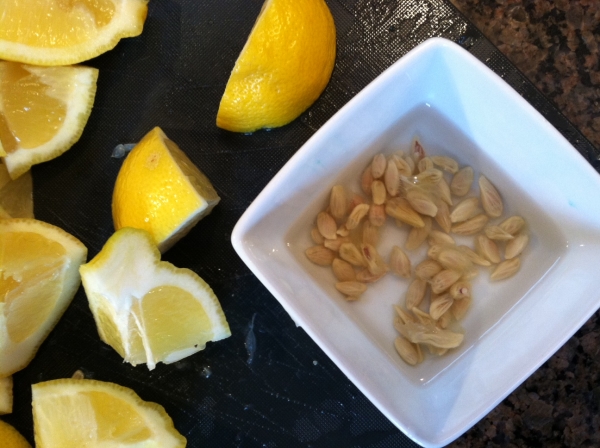
Suitable grade for the house or apartment: Pavlovsky, Meyer and others
There is a large number of varieties.Below are some of them that are suitable for growing in a house or apartment:
- Pavlovsky - differs from other varieties with its large fruits, which can reach 500 grams, has a sweetish taste, and the tree of this variety is quite large - more than 2 meters. This variety has aromatic leaves. The aroma is so sharp and strong that the whole house will be filled with it.
- Meier - a hybrid of a lemon with a grapefruit, has a sweet-sour taste, a small tree with a rich harvest, the size of one lemon can reach 150 grams, blooms with bunches of bunches, there is a seasonal period of rest.
- Ponderosis - a hybrid of a lemon with a grapefruit, differs bitterish taste, and also presence of a large number of stones. I am glad that constantly blooms. According to the people who grow this type of lemon, a very grateful plant and quite unpretentious.
- Genoa - An average tree, gives a big crop already for 4-5 years of life. Fruits with tender pulp, have a sour, fragrant taste. You can also eat peel. This variety is not considered capricious. For 2-3 years the sapling is already blooming.
- Anniversary - The tree is of medium size, it is considered a variety that gives a rich harvest, the fruit is distinguished by its thickness. Very suitable for growing in a house or apartment.
After the stage of choice of the variety has been passed, it is necessary to proceed to the planting of the seeds in the pot itself.
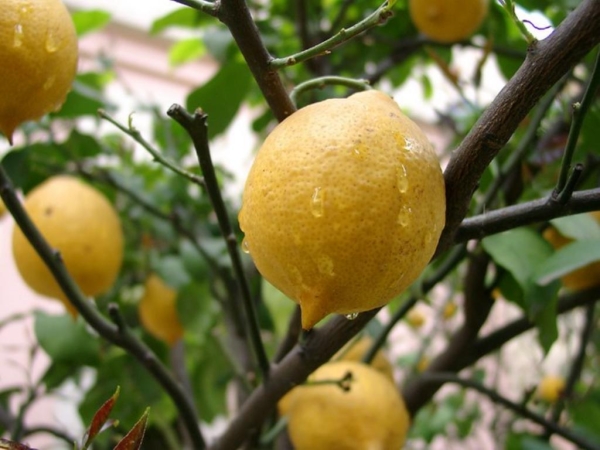
How to plant a plant seed: highlights
Some active citrus owners with a wealth of experience advised to free the bone from the top huskthat in their opinion allows you to get the seedlings in the shortest possible time.
This should be done very carefully, as any damage to the bone can lead to the fact that seed germination will not occur.
But you can plant bones and without the above procedure.
Lemon bones must be wet before planting.. It is advisable to soak them for a day in water or in a solution of sodium humate. You can purchase this growth stimulant at any botanical store.
Next, you need to find a suitable small, shallow pot or cup, pour earth into it. There should be holes in the bottom of the pots. They are important in order to excess moisture, because of which the roots of sprouts may die,flowed down.
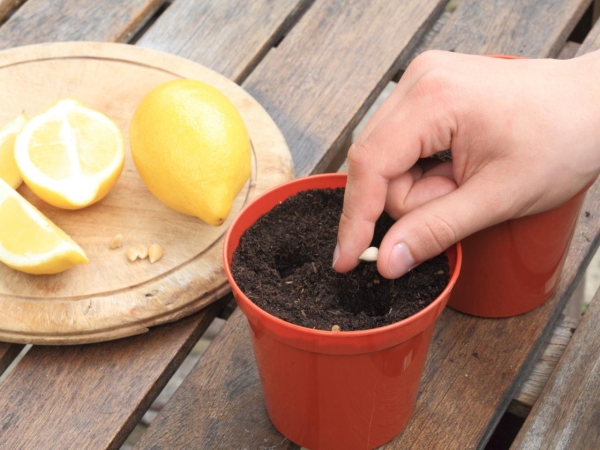
Put 1.5-2 cm of expanded clay, fine pebbles or very coarse sand on the bottom of the pot. Soil for planting can be bought in the store, and you can prepare yourself. To do this, mix the garden soil, sand, humus and some charcoal.
Planting stones is better to a depth of no more than 1.5-2 cm. Soil before planting is important to moisten. It should not be dry, but excessive moisture is also undesirable.
Spray the soil once every 2-3 days. If the ground is completely dry, then you can water it a little. After the first sprouts appear, the film must be removed.
It is better to rearrange the pot with sprouts in a bright place and water with settled or rain water at room temperature.
The first shoots will sprout no earlier than 3-4 weeks after planting.
According to experienced citrus breeders, The best time to plant a lemon is the end of winter, the beginning of spring. Since the increasing light day will only benefit the emerging young shoots.
Will the indoor lemon tree give fruit?
Many people think that growing lemon from a stone is a thankless job. So how to wait for the fruits of such a lemon will have 5, 7, or even all 15 years and its fruits will be of small size.
For, in order not to wait for decades when the lemon tree begins to bear fruit, it is necessary to instill. This can be done in two ways in the warm season (summer or warm spring):
- In split - more preferred type of grafting. It is necessary to take the stalk of a cultured fruit-bearing lemon. On the seedling pruned branch, and the remaining stem of the seedling split. On the cutting of a fruiting lemon sharpen wedges, which are then injected into the splitting in the stem. Next, you need to tie the vaccine with tape. On the stem of a fruiting lemon, 2-4 buds are left, the rest is cut off. Vaccination covered with a plastic bag. When the vaccine grows together the package can be removed.
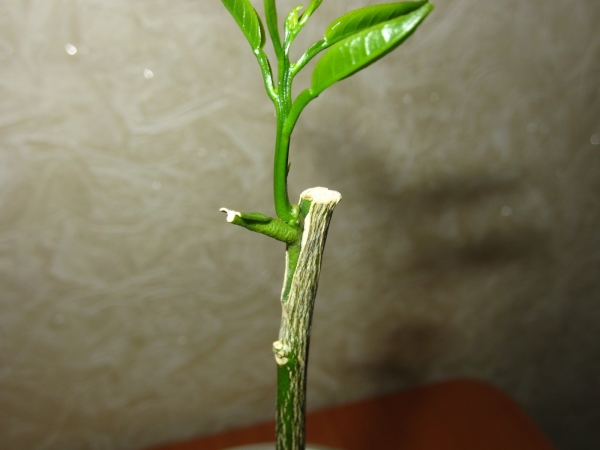
- Vulnerability - shoots are cut from a seedling, a “stump” with a height of 10 cm remains from the tree. Next, take a sprig of a fruit-bearing fruit lemon. Under each leaf of the branch there is a so-called “sleeping kidney”.It is necessary to make a cut in front of this kidney. Next, cut the leaf plate, but leave it petiole. On the seedling's “hemp”, make a cut of the bark and insert a cut down the petiole. To tie a place of an inoculation an insulating tape. The scape of the cut leaf plate will serve as an indicator. If the petiole disappears in 2-3 days, then we can assume that the inoculation has worked, if it dries out, it means that the inoculation has failed and must be repeated.
Interesting thing is that grown lemon from the stone adapts to home conditions faster and better, it is less picky than cuttings and grafted seedlings.
Why is not the fruit of a lemon grown from a seed:
Optimum conditions for growing, care after planting
To the lemon which has risen in a pot it is desirable to be very attentive. When on lemon seedlings 3-4 leaves will appear, they are transplanted into separate pots.
Lemon saplings are recommended to replant up to 2 times a year. It is advisable to do this very carefully so as not to damage the root system.
And the best solution is not to change the place of residence of the lemon.The best place for a lemon will be the south or south-west side of the apartment. As for the temperature, the lemon can tolerate temperatures from + 14 to + 27.

Lemon creates conditions without sudden temperature fluctuations.since they can kill him. It is desirable to maintain a moderate humidity of air - 60-70%.
Water the plant Best at room temperature rainwater. Hot summer is better to do it 2 times a day. And on cloudy and cold days it is important to add lighting to the lemon by means of LED or fluorescent lamps.
In the summer to feed seedling can be a solution of humus and liquid mineral fertilizers.
Lemons, like all indoor plants prone to disease and pest attack. Therefore, they require careful care, and it is recommended that you carefully examine the plant every day in order to detect the occurrence of a pest as early as possible and take the necessary measures in time.
Take care and protect: the main enemies of citrus
Lemon is sick if you do not follow the rules of care. If the tree is not watered, it will dry.If the ground in a pot overwhelm moisture, then yellow leaves will appear on the lemon, and this will be a sign that the roots of the tree are starting to rot.
Also the appearance of yellow spots on the foliage, after which the leaves dry and fall off, indicate that the tree lacks iron.
Drying leaves They say that the tree needs phosphorus. A lack of potassium and manganese leads to wrinkling of the leaves and falling off of the ovary.
The following are some common parasites that can attack home-grown lemon:
- Mealybugs, popularly known as "shaggy lice" - on the tree they can be recognized by white bloom. They prefer dry conditions, they are afraid of moisture. A good prevention of this parasite will be regular washing of all the leaves of a lemon.
- Shchitovka - on the leaves are small shiny droplets, sticky to the touch. Leaves dry and fall off. Against this pest use soapy or garlic water.Soapy water is prepared as follows: 2 tablespoons of liquid soap are dissolved in 1 liter of water. The resulting mixture is treated the affected tree. An hour after the procedure - wash under the shower. Repeat treatment preferably after 2 days.
- Spider mite - small, light dots on the sheet plate. The leaves fold. On their reverse side the web is visualized. If this parasite was found on a lemon, it is necessary to treat the tree with sulfur. In order to prevent lemon washed under running water, paying more attention to the lower side of the leaf plates of the tree. Well helps to deal with mite spraying a solution of water with soap.
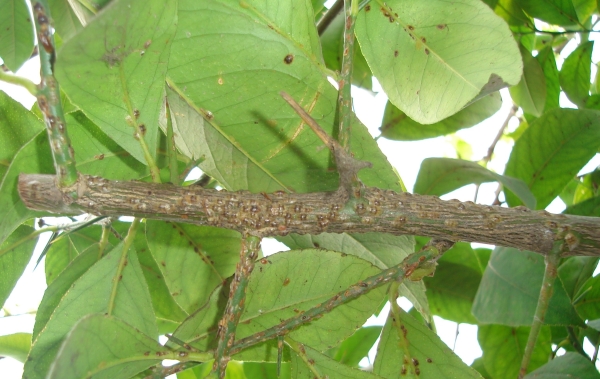
Preventive measures
There are several simple preventive measures that will prevent the onset of a parasite attack or tree damage by diseases:
- arrange a lemon tree bathing in the shower hot water. The plant will not suffer from this, and the unsung parasites will be neutralized and washed away;
- spray leaves (especially from the bottom);
- wipe lemon leaves once a week with soapy water (it is better to use soap).
Lemon tree is not geranium, it needs competent care and for a beginner it is very difficult to figure out what, how and when to do it.
Having put efforts and having studied rules of care for a lemon, it is possible to receive pleasant result. Home-grown lemon will delight not only with its aroma, but also with tasty fruits.
Growing lemon from the stone:
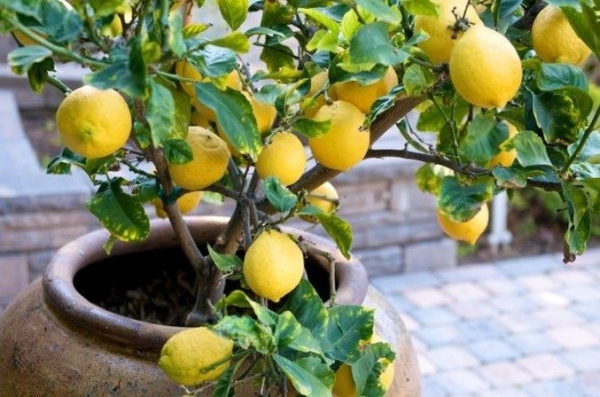
My citrus tree is over 25 years old. It was grown from seed. At first he grew up a little and was tall. See 30 for many years. After transferring to a bigger pot, it began to grow and now has reached a size of about 1.5 meters, but has not yet blossomed. The plant has spines of 2 cm, and the leaves are attached by a figured handle to the branches. I can not understand what kind of tree, at first I thought it was a lemon, but now I doubt it. Maybe it's an orange or a tangerine? It stands by the window on the south side, a pot of 6-7 liters. How to understand what kind of tree?